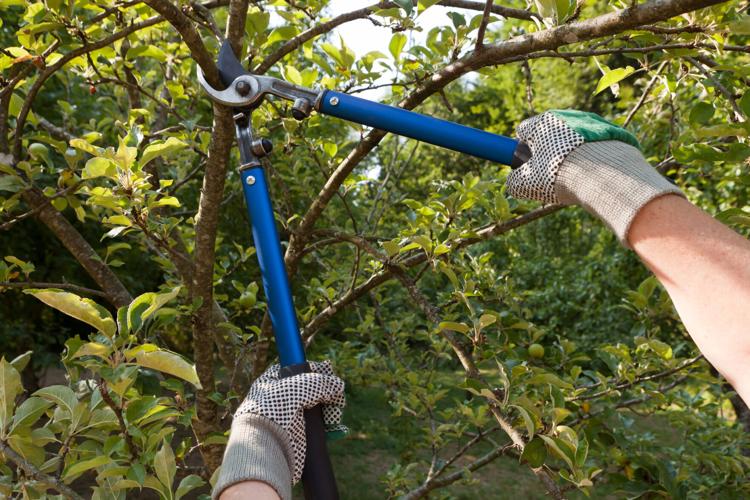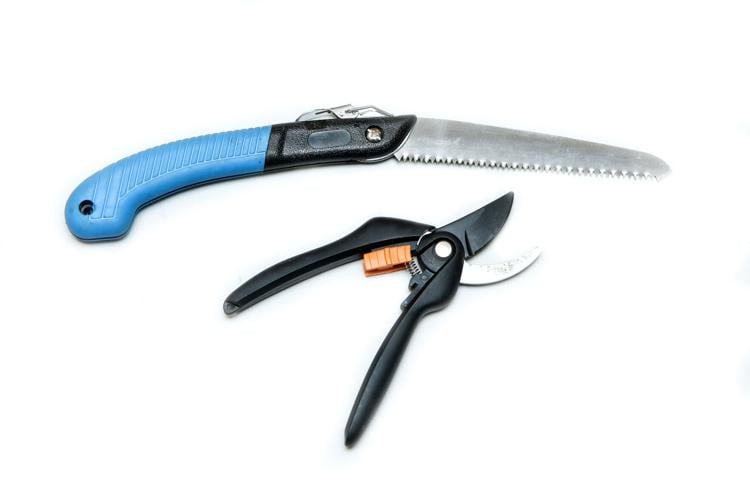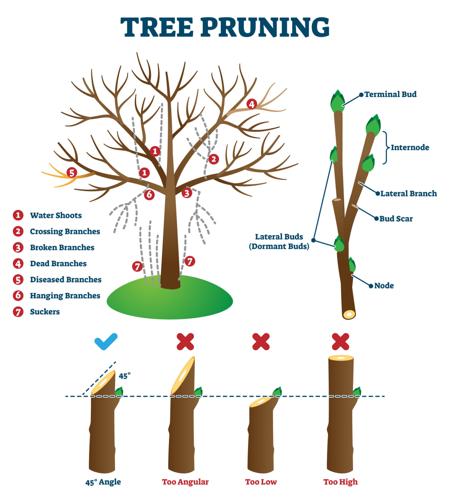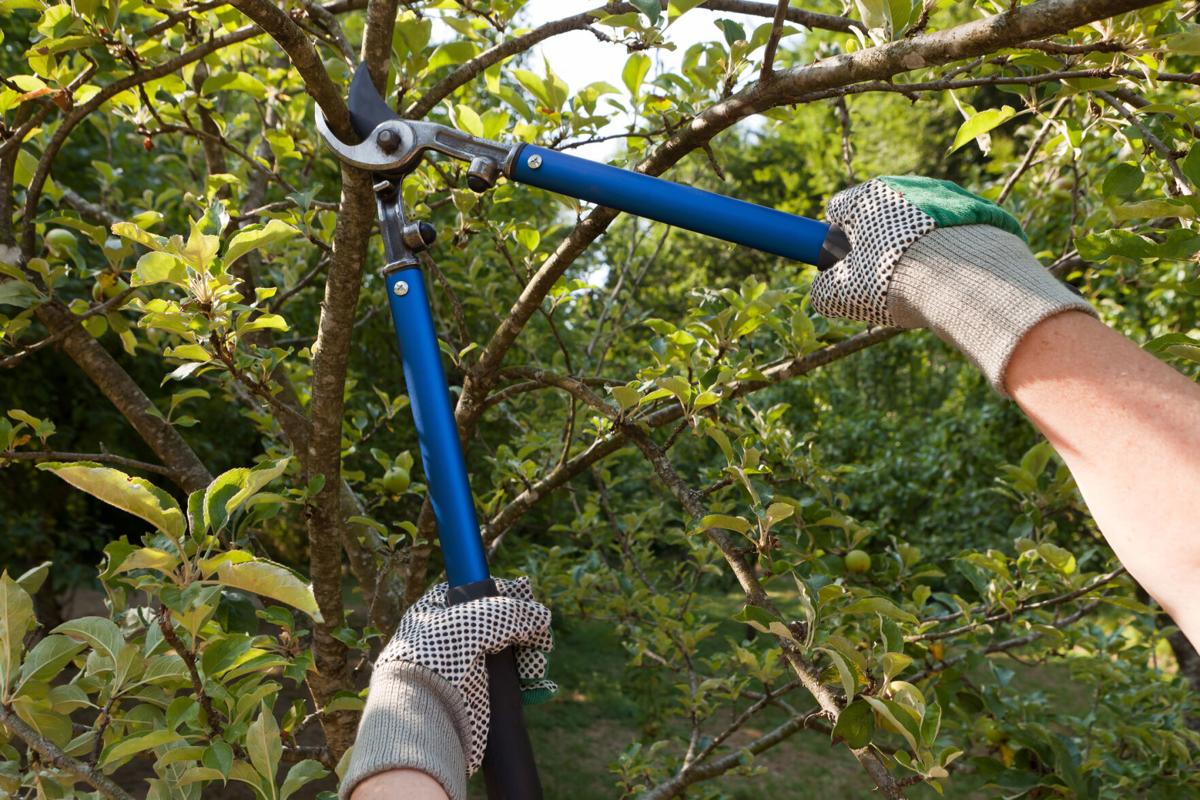Fall is a good time for pruning many plants. However, many people don’t prune correctly, which can make your plants unsightly and even damage them or shorten their lifespan. Even some landscapers don’t prune correctly, particularly when it comes to our native plants. In light of that, I thought I’d share some basic tips so you can do some of your own pruning without hurting your plants, or at least keep an eye on what your landscapers are doing.
Tools
The most useful pruning tool, and the one I use most often is hand-held pruning shears, also called pruners, secateurs, or clippers. These are good for branches up to ¾ inch in diameter.
If you plan on pruning larger branches, you should also get loppers, which work for branches up to 2½ inch diameter, depending on the lopper size. The tool will have a label on it that tells you what size branches it can handle. Don’t use them on larger branches — you will break your pruners. Trust me, I know. In any case, I prefer a hand-held pruning saw for branches over 2 inches in diameter.
For branches larger than 3 inches in diameter, I highly recommend you get a professional to help you. It will be difficult for you to safely maneuver these larger branches to the ground — they weigh more than you think. You will end up damaging the bark, neighboring branches, and possibly yourself in the process.
Make sure you purchase bypass pruners, not anvil pruners. Anvil pruners have only one blade, and tend to cause crush injury to your plant’s branches, which is more difficult to heal. Only use anvil pruners to chop up dead branches.

Pruning shears are used for smaller branches, while a hand saw is useful for cutting branches more than 2½ inches in diameter.
Types of pruning
Thinning: This type of pruning is a common way for gardeners to make a plant less bulky. Don’t remove more than ⅓ of the mass of the plant per season.
Rejuvenation pruning: This is an extreme technique used as a last resort to salvage plants that have been damaged by improper pruning. It involves cutting all of the branches down to about 2-3 inches. It may result in a dead plant, so do this only if you have no other choice. Texas rangers can sometimes respond well to this treatment. However, don’t do it more than once, or you are quite likely to kill your plant. The exception is red bird of paradise shrubs (Caesalpinia pulcherrima), which tolerate yearly rejuvenation pruning.
Shearing: This technique is used to shape plants into unnatural shapes, such as cubes, spheres, disks and the like. Only a handful of shrubs in our climate do well with this type of pruning. Most shrubs end up damaged, with reduced flowering and unsightly naked branches. This is because plants must have two characteristics to do well with shearing: small leaves, and lots of lateral buds growing close together. Any plants without these characteristics will end up looking ugly and doing poorly. In friendlier climates, shrubs that can be sheared include Japanese boxwood (Buxus microphylla japonica), waxleaf privet (Ligustrum japonicum), xylosma (Xylosma congestum), and myrtle (Myrtus communis). One native shrub that can be sheared is jojoba (Simmondsia chinensis).
Taking care of your tools
Keeping your tools sharp and rust-free is key to reducing the damage to your plants. To remove rust, you can disassemble the tool and soak it in a weak vinegar solution overnight, then scrub the rust off gently. This WikiHow article will take you through all of the cleaning steps. You can sharpen tools with a whetstone, a file, or similar tool. This article will help you figure out how to sharpen your various gardening tools.
Once you’ve cleaned and sharpened them, keep them clean and dry to prevent further damage. You can wipe the tools off after each use, and use mineral oil or WD-40 to keep them from rusting. Cleaning your pruners properly will also prevent plant diseases from spreading. You can use solvents such as kerosene to clean sap off your tools.
What to prune
The rule of thumb is to prune dead, damaged, diseased, or dangerous limbs — the 4 Ds. However, it’s usually good to wait to prune until the appropriate time (see below). The only exception to this is if a branch is posing a hazard to people or property — then it needs to be removed as soon as possible. In these instances, however, you should get a professional to do it. Broken branches, particularly large ones, can be unpredictable.
When thinning a plant, be sure to remove branches that are touching or crossing. This is particularly important in trees. Rubbing branches will damage each other and may cause weakness and disease.
If you’re pruning diseased plant material, make sure not to toss it on the ground or your compost pile. Throw it away in the trash. Be sure to clean your pruners thoroughly with Lysol or a similar cleaner afterwards to avoid spreading the disease to other plants.
Note that you should not be pruning regularly to decrease the size of your plants. If your plants are too big for their spot, consider moving them and replacing with a smaller plant.
How to prune
To remove single branches due to one of the 4 Ds, cut the branch at a 45-degree angle where it originates on the main stem of a plant. Alternatively, you can also cut it where it originates from a thicker branch. Cut just beyond the joint where the branch comes off (see illustration).

This diagram show the types of cuts that should be made during pruning. Cut at a 45-degree angle, and just on the far side of the next bud.
To thin your plants, start by removing dead and diseased branches. Then remove branches that are tangled or crossed. Again, cut the branches at their origin points just on the far side of the bud that’s closer to the main branch.
Whenever you remove a branch, you are stimulating hormones in the plant that encourage new growth. Keep this in mind when you’re cutting. Do you want new branches at that site? Think about how the plant will look in a few months when it regrows more branches. This takes some experience, so don’t trim off too much at any one time, especially while you’re learning. You can always trim off more, but you can’t put back what you’ve cut off. Avoid removing more than ⅓ of the plant in a single season to avoid stressing or killing it.
When to prune
For flowering and fruiting trees and shrubs, timing your pruning is important to avoid sacrificing this year’s flowers or fruit. The general rule is to prune spring-flowering trees or shrubs after their flowers have fallen (late spring or early summer). For summer bloomers, late winter is best, but keep our frost dates in mind (mid-November through mid-March). Pruning triggers new growth, which will be damaged by frost.
Dormant deciduous trees can be pruned towards the end of their dormancy — late winter or early spring. For some plants, flowers or fruit grow on second-year growth, so be sure to check your plant’s specific requirements before pruning.
Do not prune frost-damaged branches until all danger of frost has passed. The dead ends protect the living branch from further frost damage.
Safety when pruning
As mentioned above, leave pruning of larger (3 inches or more) branches to the experts. In addition, make sure you always wear safety glasses and long sleeves when pruning. This will protect you from scratches and bruises from stray branches. In particular, protect your eyes. I cannot emphasize this enough — not only can you scratch or perforate your eye, resulting in permanent damage, but in addition, plants may have various irritants and toxins that can result in chemical damage to your eye. Make sure you wear wrap-around eye protection — glasses aren’t enough. For very thorny plants, wear thick clothing to protect your skin, as well.
I also highly recommend avoiding any pruning that requires you to stand on a ladder. Even small falls can result in broken bones which take longer to heal as we age. Get a professional to do this for you.
What not to prune
Don’t prune conifers and palm trees without professional help or advice. Not only is it potentially dangerous (in the case of tall trees), there is a high chance of permanently ruining the tree if you do it incorrectly.
Resources
- Check out the upcoming virtual class at Tucson Botanical Gardens: Fall Tree Pruning 101. Nov. 2, 10 a.m. to noon. $30.
- Pruning Deciduous Shade Trees from the University of Arizona Extension office.
- Pruning Shrubs in the Low and Mid-Elevation Deserts in Arizona from the University of Arizona Extension office.







